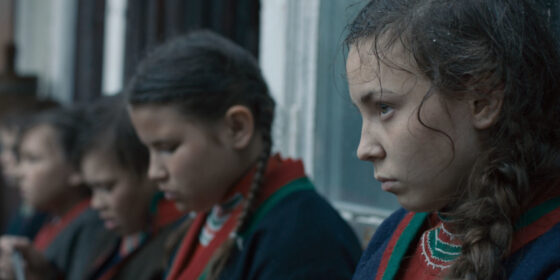Sámi Blood (Amanda Kernell, Sweden/Denmark/Norway) — Discovery
By Jennifer Lynde Barker
Language marks us. What seems innocuous in a familiar setting becomes abruptly conspicuous when contrasted with different sounds and intonations. This makes language an easy target for discrimination, perhaps because we seldom feel more vulnerable than when we cannot understand what someone else is saying. Being denied comprehension means being shut out of a world we would like to control. On the other hand, speaking the wrong language shuts us out of worlds we would like to join. In Swedish Sámi director Amanda Kernell’s feature-film debut, language—as a marker for identity—takes on a central role in an exploration of the relationship between Swedes and Sámi in the 1930s. The film deftly portrays the alienating effect that vicious institutional and personal prejudice has on Sámi sisters Elle-Marja and Njenna (portrayed respectively by real-life sisters Lena Cecilia Sparrok and Mia Erika Sparrok). The two are children of reindeer herders, but are required to attend boarding school where they learn Swedish language and culture. They react differently to the situation: Elle-Marja internalizes Swedish prejudices about the Sámi and wants to pursue further education in Uppsala, while the younger Njenna misses home and is confused and hurt by her sister’s desire to pass as Swedish.
The film is structured as a long flashback prompted by Njenna’s death. Elle-Marja (who has renamed herself Christina, here played by Maj Doris Rimpi), reluctantly travels north to the funeral with her son and granddaughter. She is bitter and self-hating towards her Sámi heritage and refuses to talk to anyone. But the long-abandoned surroundings awaken her memories and she relives the weeks leading up to the moment she broke with her family and sold her Sámi past for a Swedish future. It is a sign of the times that she could not inhabit both worlds: her options are cruelly either/or. The film chronicles the methods of alienation and judgment popular at the time, including phrenology and a callous anthropology. The subjugation of the Sámi children to the clinical inspection of their difference and presumed inferiority is shot without sentiment yet clearly conveys their humiliation. In contrast, positive connections are inflected through touch: Kernell creates a nuanced tenderness between characters, especially the women, which transcends differences.
The camerawork keeps us up close to the characters and objects, where we develop an intimate understanding of who and what they are. Elle-Marja’s apprehension of the world is sensuous and eager: in the pre-dawn hours she picks up and explores the objects of her Swedish lover’s bourgeois household (the cuts in a crystal bowl, ivory piano keys); after she sleeps with him, we see her tracing his skin with semen. Lena Cecilia Sparrok seems to soak in new experiences by osmosis: her character is curious and courageous and she acts without fear or thought of consequences. These qualities are necessary for her to pass in the other world, but not without loss or scars. When she angrily defies the boys who are mocking her, they take their revenge by marking her ear as if she were a reindeer. Yet this is only the outer evidence of the scarring within: she wounds her self in order to lead a different life, and the rejection of her family is stained with blood. When she leaves, she loses the ability to sing her experience: joking is a form of Sámi expression that she can’t bring with her. But when she returns at last we see that it is not too late for her to find a way to be bilingual.
Jennifer Lynde Barker- « Previous
- 1
- 2



